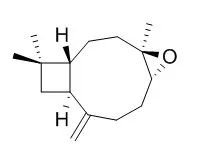| Description: |
Caryophyllene oxide, an oxygenated terpenoid existed in many plant essential oil, is well known as preservative in food, drugs and cosmetics with antifungal, acaricidal, anti-inflammatory, anti-carcinogenic, significant central as well as peripheral analgesic and skin penetration enhancing properties. Caryophyllene Oxide and lupenone have synergistic effect against Trypanosoma cruzi. It inhibited growth and induces apoptosis through the suppression of PI3K/AKT/mTOR/S6K1 pathways, ROS-mediated MAPKs activation, and via modulation of 15-LOX. |
| In vitro: |
| Antiinflamm Antiallergy Agents Med Chem. 2014 Mar;13(1):45-55. | | Beta caryophyllene and caryophyllene oxide, isolated from Aegle marmelos, as the potent anti-inflammatory agents against lymphoma and neuroblastoma cells.[Pubmed: 24484210] | Aegle marmelos (Indian Bael) is a tree which belongs to the family of Rutaceae. It holds a prominent position in both Indian medicine and Indian culture.
METHODS AND RESULTS:
We have screened various fractions of Aegle marmelos extracts for their anticancer properties using in vitro cell models. Gas chromatography-Mass spectrometry (GC-MS) was employed to analyze the biomolecules present in the Aegle marmelos extract. Jurkat and human neuroblastoma (IMR-32) cells were treated with different concentrations of the fractionated Aegle marmelos extracts. Flow cytometric analysis revealed that optimal concentration (50 μg/ml) of beta caryophyllene and Caryophyllene oxide fractions of Aegle marmelos extract can induce apoptosis in Jurkat cell line. cDNA expression profiling of pro-apoptotic and anti-apoptotic genes was carried out using real time PCR (RT-PCR). Down-regulation of anti-apoptotic genes (bcl-2, mdm2, cox2 and cmyb) and up-regulation of pro-apoptotic genes (bax, bak1, caspase-8, caspase-9 and ATM) in Jurkat and IMR-32 cells treated with the beta caryophyllene and Caryophyllene oxide fractions of Aegle marmelos extract revealed the insights of the downstream apoptotic mechanism. Furthermore, in-silico approach was employed to understand the upstream target involved in the induction of apoptosis by the beta caryophyllene and Caryophyllene oxide fractions of Aegle marmelos extract.
CONCLUSIONS:
Herein, we report that beta caryophyllene and Caryophyllene oxide isolated from Aegle marmelos can act as potent anti-inflammatory agents and modulators of a newly established therapeutic target, 15-lipoxygenase (15-LOX). Beta caryophyllene and Caryophyllene oxide can induce apoptosis in lymphoma and neuroblastoma cells via modulation of 15-LOX (up-stream target) followed by the down-regulation of anti-apoptotic and up-regulation of pro-apoptotic genes. |
|
| In vivo: |
| Phytomedicine. 2010 Feb;17(2):149-51. | | Analgesic and anti-inflammatory activity of Caryophyllene oxide from Annona squamosa L. bark.[Pubmed: 19576741] | Caryophyllene oxide was isolated from an unsaponified petroleum ether extract of the bark of Annona squamosa and studied for its analgesic and anti-inflammatory activity.
METHODS AND RESULTS:
Caryophyllene oxide at the doses of 12.5 and 25mg/kg body wt. and unsaponified petroleum ether extract at a dose of 50mg/kg body wt. showed significant central as well as peripheral analgesic, along with anti-inflammatory, activity.
CONCLUSIONS:
These activities of Caryophyllene oxide were comparable with the standard drug used in the respective experiments. | | Cancer Lett. 2011 Dec 22;312(2):178-88 | | β-Caryophyllene oxide inhibits growth and induces apoptosis through the suppression of PI3K/AKT/mTOR/S6K1 pathways and ROS-mediated MAPKs activation.[Pubmed: 21924548] | Both PI3K/AKT/mTOR/S6K1 and mitogen activated protein kinase (MAPK) signaling cascades play an important role in cell proliferation, survival, angiogenesis, and metastasis of tumor cells.
METHODS AND RESULTS:
In the present report, we investigated the effects of β-Caryophyllene oxide (CPO), a sesquiterpene isolated from essential oils of medicinal plants such as guava (Psidium guajava), oregano (Origanum vulgare L.), cinnamon (Cinnamomum spp.) clove (Eugenia caryophyllata), and black pepper (Piper nigrum L.) on the PI3K/AKT/mTOR/S6K1 and MAPK activation pathways in human prostate and breast cancer cells. We found that CPO not only inhibited the constitutive activation of PI3K/AKT/mTOR/S6K1 signaling cascade; but also caused the activation of ERK, JNK, and p38 MAPK in tumor cells. CPO induced increased reactive oxygen species (ROS) generation from mitochondria, which is associated with the induction of apoptosis as characterized by positive Annexin V binding and TUNEL staining, loss of mitochondrial membrane potential, release of cytochrome c, activation of caspase-3, and cleavage of PARP. Inhibition of ROS generation by N-acetylcysteine (NAC) significantly prevented CPO-induced apoptosis. Subsequently, CPO also down-regulated the expression of various downstream gene products that mediate cell proliferation (cyclin D1), survival (bcl-2, bcl-xL, survivin, IAP-1, and IAP-2), metastasis (COX-2), angiogenesis (VEGF), and increased the expression of p53 and p21. Interestingly, we also observed that CPO can significantly potentiate the apoptotic effects of various pharmacological PI3K/AKT inhibitors when employed in combination in tumor cells.
CONCLUSIONS:
Overall, these findings suggest that CPO can interfere with multiple signaling cascades involved in tumorigenesis and used as a potential therapeutic candidate for both the prevention and treatment of cancer. |
|






 Cell. 2018 Jan 11;172(1-2):249-261.e12. doi: 10.1016/j.cell.2017.12.019.IF=36.216(2019)
Cell. 2018 Jan 11;172(1-2):249-261.e12. doi: 10.1016/j.cell.2017.12.019.IF=36.216(2019) Cell Metab. 2020 Mar 3;31(3):534-548.e5. doi: 10.1016/j.cmet.2020.01.002.IF=22.415(2019)
Cell Metab. 2020 Mar 3;31(3):534-548.e5. doi: 10.1016/j.cmet.2020.01.002.IF=22.415(2019) Mol Cell. 2017 Nov 16;68(4):673-685.e6. doi: 10.1016/j.molcel.2017.10.022.IF=14.548(2019)
Mol Cell. 2017 Nov 16;68(4):673-685.e6. doi: 10.1016/j.molcel.2017.10.022.IF=14.548(2019)